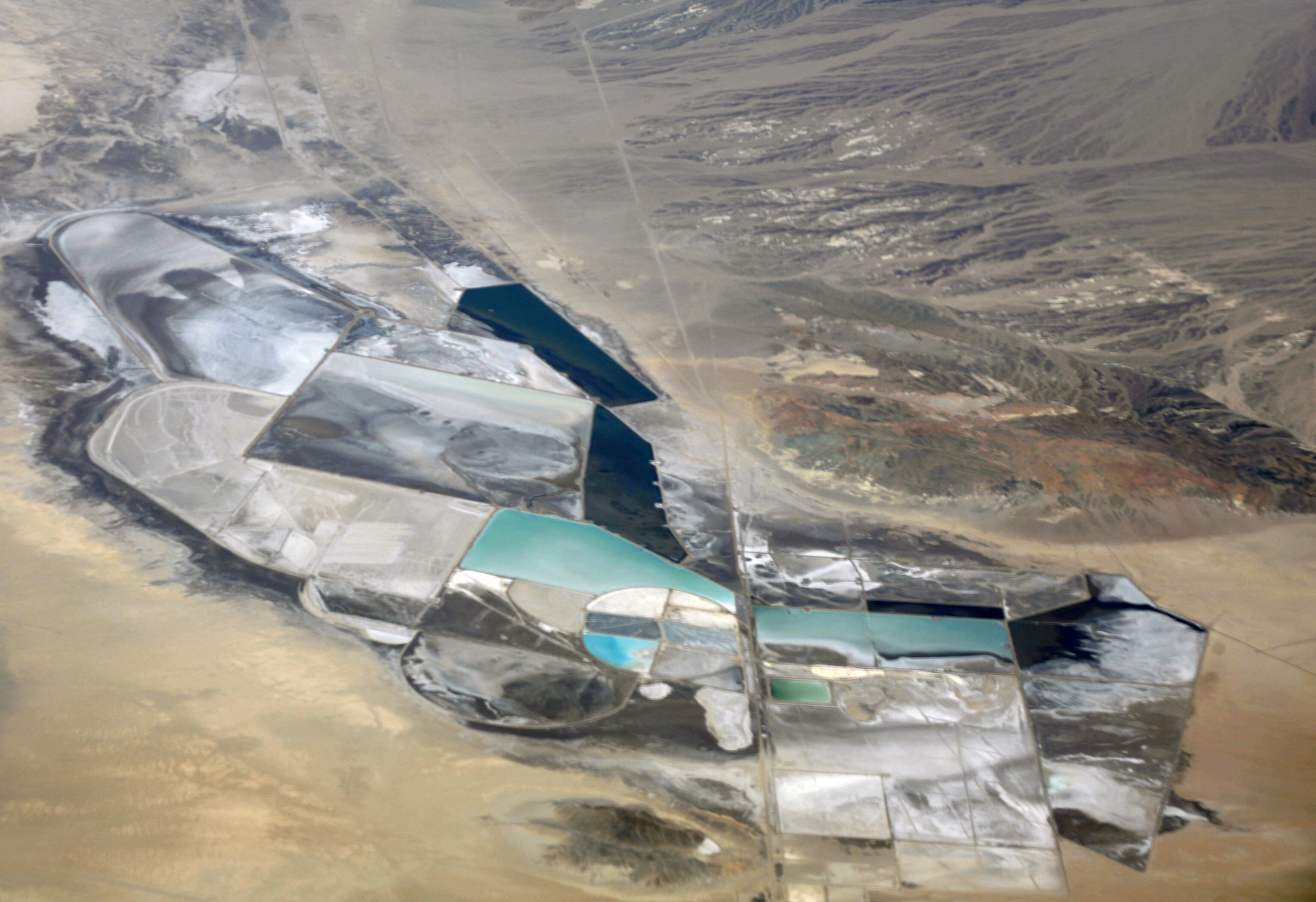Above: The Chemetall Foote Lithium Operation in Clayton Valley, a dry lake bed in Esmeralda County, Nevada, just east of Silver Peak, a tiny town that has been host to various kinds of mining for about 150 years. Credit: Doc Searles, Creative Commons License.
The race for lithium, a critical component powering the green revolution, is heating up in Nevada.
With over 80 lithium projects proposed for the state’s public lands, mining for this element has the opportunity to create thousands of jobs and expand Nevada’s clean energy economy, while its uses in batteries could improve the efficiency of electric vehicles and devices.
But there are still certain limitations to lithium as a resource, including issues related to methods of lithium extraction and the current storage capabilities of lithium-ion batteries, both of which are being researched at the University of Nevada, Reno.
Mining for lithium can be resource-intensive, with significant implications for land use and water consumption. The environmental impacts of traditional lithium extraction methods are important to consider, especially in Nevada.
Conventional geothermal brine methods predominantly used in South America, involve pumping brine extractions containing lithium carbonate from the ground and evaporating them in large ponds, using copious amounts of water and land.
Ehsan Vahidi from the Department of Mining and Metallurgical Engineering at UNR has been researching the potential of Direct Lithium Extraction (DLE) as an alternative to this traditional method.
“When we talk about Direct Lithium Extraction, DLE, It’s about brine, similar to the second resource in South America,” Vahidi said. “The difference is that they don’t use evaporation ponds, they don’t use sunlight. They don’t use a lot of lands.”
In a recent study published in March, Vahidi and his Ph.D. students researched the viability of DLE based on data from a mine in Clayton Valley, Nev., where a pilot program is already underway using this method. Unlike conventional systems that pump water from the ground and evaporate it to concentrate the lithium, DLE minimizes direct water consumption by recycling and reusing groundwater, also reducing CO2 emissions produced by the process.
“The most important thing in Nevada is water,” Vahidi said. “You extract water from underground and you evaporate that water in an area where we have problems with water. So that is the major problem in Nevada.
Currently, there is only one active Lithium mine in the US, located in Silver Peak, Nevada, which uses the conventional brine method of extraction. Direct Lithium extraction could replace this method.
“For DLE, they claim that they can recycle 99%, almost 100% of water and they can return the water into the groundwater in the ground system,” Vahidi said. “So, no evaporation.”
However, this method is highly energy intensive due to the technology system used to recycle the water. Solar panels are a fitting answer to this problem, especially in Nevada where we have lots of open public land and sunlight. There is also concern about the adoption of DLE as an alternative due to it being a new system.
“DLE is a kind of, you know, challenging, questionable process,” Vahidi said. “Nobody believes that a company can be profitable using DLE.”
Lithium is primarily used in the production of Lithium-Ion batteries, which power electric vehicles and handheld electronics. However, these batteries also face limitations in their current storage capacities.
UNR doctoral candidate Jason Mennel has been researching Lithium-ion batteries for the last four years, working to improve the energy capacities that these batteries are capable of.
“With the increasing demand of energy needs, not only from portable electronics but electric vehicles, it is necessary to increase the energy density, that’s a popular term, to increase the energy density of our lithium-ion batteries from what they can give now to something two or three or four times more the energy capacity,” Mennel said.
While there are other resources that could be used in the formation of batteries, Mennel pointed out that lithium is the most efficient.
“We need more energy storage capabilities,” Mennel said. “The most promising at least for portability, sure, there’s hydroelectric dams and other energy storage methods, but for at least portability is lithium-ion batteries. And so it is definitely a necessity. If we were to transition and to and electrify everything or at least electrify quickly mentality.”
Despite the implications associated with lithium as a resource, the potential benefits and advancements hold promise for significantly enhancing the green revolution.
Sydney Peerman is a recent graduate of the Reynolds School of Journalism with a minor in environmental studies and political science. She is the summer 2024 Hitchcock Project intern at KUNR, and completed this story for her science reporting class during spring 2024.






